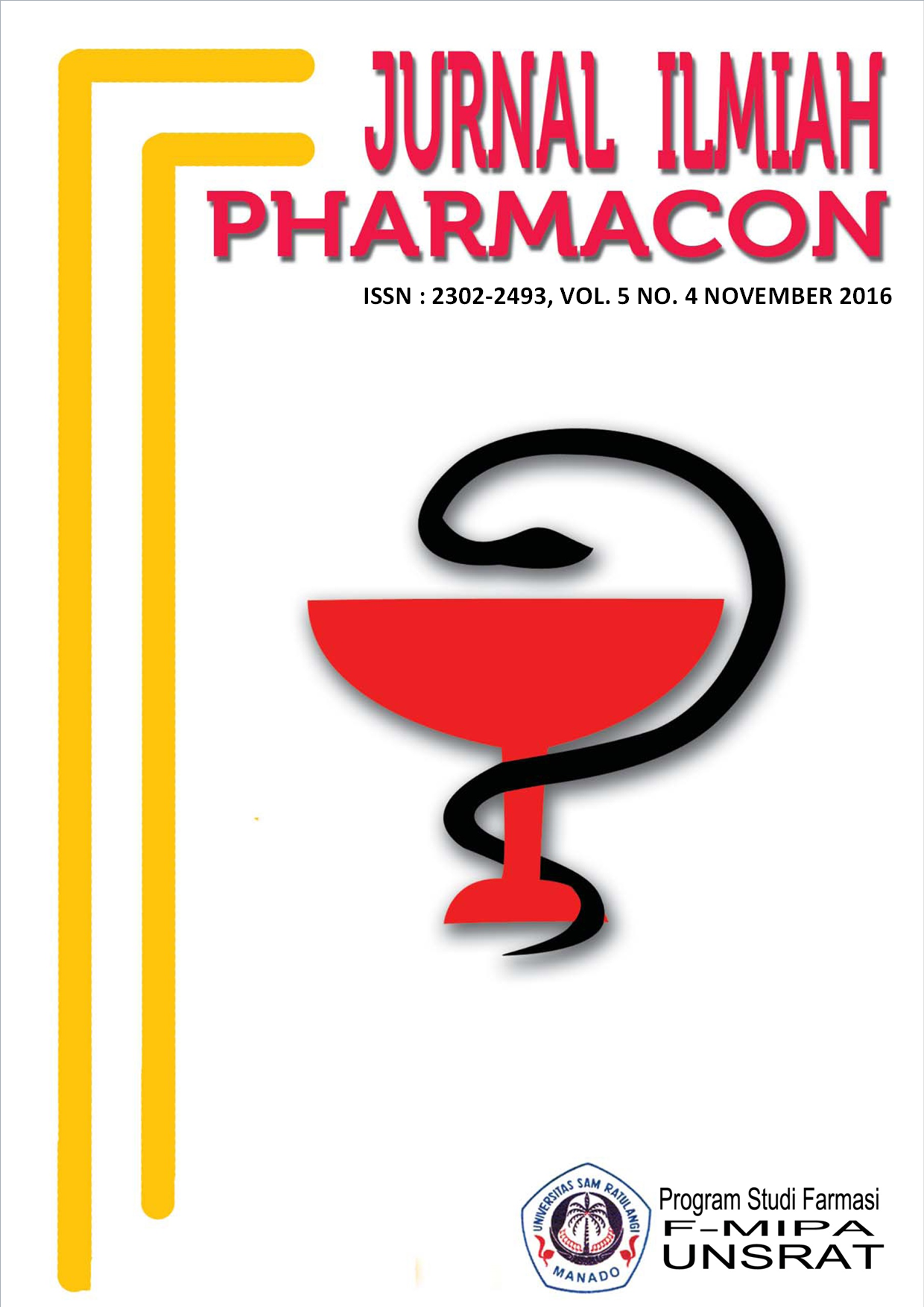UJI KONSENTRASI HAMBAT MINIMUM (KHM) EKSTRAK KULIT NANAS (Ananas comosus L) TERHADAP Staphylococcus aureus
DOI:
https://doi.org/10.35799/pha.5.2016.13969Abstract
UJI KONSENTRASI HAMBAT MINIMUM (KHM) EKSTRAK KULIT NANAS (Ananas comosus L) TERHADAP Staphylococcus aureus
Indria Wiharningtias1) , Olivia Waworuntu2), Juliatri1)
1) Program Studi Pendidikan Dokter Gigi Fakultas Kedokteran UNSRAT Manado, 95115
2)Fakultas Kedokteran UNSRAT Manado, 95115
Â
Â
ABSTRACT
    Staphylococcus aureus is one of the bacteria in oral cavity that can lead to an abscess. Treatment of abscesses can be done by use of systemic antibiotics, but now the increasingly of Staphylococcus aureus bacteria resistant to antibiotics has become a problem in the medical. Various alternatives have been developed, one of them using natural materials to inhibit the growth of Staphylococcus aureus. Pineapple (Ananas comosus L) was a plant that grows in Indonesia. The peel of pineapple contains of bromelain enzyme and has anti-bacterial effect, but the pineapple’s peel were not widely used in Indonesia. The purpose of this research is to determine the Minimum Inhibitory Concentration (MIC) of pineapple peel extract (Ananas comosus L) to Staphylococcus aureus growth. This research is a true experimental research with randomized pretes- posttest control group design. The method used in this research is serial dilution methods with turbidimetry and spectrophotometry as the test methods. Pineapple peel was extracted with maceration method using ethanol 96%. The extract used in this study are 0.39 %, 0.78 %, 1.56%, 3.125 %, 6.25%, 12.5 %, 25 %, 50 % and 100 %.The result of this research showed that the Minimum Inhibitory Concentration (MIC) of pineapple peel extract (Ananas comosus L) to Staphylococcus aureus was 1,56%.
Keywords: Staphylococcus aureus, Minimum Inhibitory Concentration (MIC), pineapple peel
Â
ABSTRAK
Staphylococcus aureus merupakan salah satu bakteri di dalam rongga mulut yang dapat menyebabkan terjadinya abses. Perawatan terhadap abses dapat dilakukan secara sistemik yaitu dengan penggunaan antibiotik, namun saat ini peningkatan resistensi bakteri Staphylococcus aureus terhadap antibiotik telah menjadi permasalahan dalam bidang kesehatan. Berbagai cara alternatif telah dikembangkan, salah satunya dengan memanfaatkan bahan alami untuk menghambat pertumbuhan Staphylococcus aureus. Nanas (Ananas comosus L) merupakan tanaman yang banyak tumbuh di Indonesia. Kulit buah nanas mengandung enzim bromelain dan memiliki efek sebagai anti bakteri, namun pemanfaatan kulit nanas belum banyak dilakukan di Indonesia. Tujuan penelitian ini yaitu untuk mengetahui konsentrasi hambat minimum (KHM) dari ekstrak kulit nanas terhadap pertumbuhan Staphylococcus aureus. Penelitian ini merupakan penelitian eksperimental murni (true experimental design) dengan rancangan penelitian randomized pretes- posttest control group design. Metode yang digunakan dalam penelitian ini yaitu metode serial dilusi dengan metode pengujian turbidimetri dan spektrofotometri. Ekstrak kulit nanas didapat dengan metode maserasi menggunakan pelarut etanol 96%. Konsentrasi ekstrak yang digunakan dalam penelitian ini yaitu 0,39%, 0,78%, 1,56%, 3,125%, 6,25%, 12,5%, 25%, 50%, dan 100%. Hasil penelitian ini menunjukkan bahwa, konsentrasi hambat minumum ekstrak kulit nanas (Ananas comosus L) terhadap Staphylococcus aureus yaitu konsentrasi 1,56%.
Kata kunci: Staphylococcus aureus, Konsentrasi Hambat Minimum (KHM), kulit nanas
Â
Downloads
Published
How to Cite
Issue
Section
License
Authors who publish with this journal agree to the following terms:
- Authors retain copyright and grant the journal right of first publication with the work simultaneously licensed under a Creative Commons Attribution-NonCommercial 4.0 International License that allows others to share the work with an acknowledgement of the work's authorship and initial publication in this journal.
- Authors are permitted and encouraged to post their work online (e.g., in institutional repositories or on their website) prior to and during the submission process, as it can lead to productive exchanges, as well as earlier and greater citation of published work (See The Effect of Open Access)










